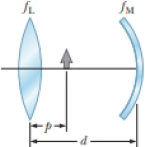
Concept explainers
Why is the following situation impossible? Consider the lens–mirror combination shown in Figure P35.55. The lens has a focal length of fL = 0.200 m, and the mirror has a focal length of fM = 0.500 m. The lens and mirror are placed a distance d = 1.30 m apart, and an object is placed at p = 0.300 m from the lens. By moving a screen to various positions to the left of the lens, a student finds two different positions of the screen that produce a sharp image of the object. One of these positions corresponds to light leaving the object and traveling to the left through the lens. The other position corresponds to light traveling to the right from the object, reflecting from the mirror and then passing through the lens.
Figure P35.55 Problem 55 and 57.

Want to see the full answer?
Check out a sample textbook solution
Chapter 35 Solutions
Bundle: Physics for Scientists and Engineers, Volume 2, Loose-leaf Version, 10th + WebAssign Printed Access Card for Serway/Jewett's Physics for Scientists and Engineers, 10th, Multi-Term
- In Figure P35.30, a thin converging lens of focal length 14.0 cm forms an image of the square abed, which is he = hb = 10.0 cm high and lies between distances of pd = 20.0 cm and pa = 30.0 cm from the lens. Let a, b, c. and d represent the respective corners of the image. Let qa represent the image distance for points a and b, qd represent the image distance for points c and d, hb, represent the distance from point b to the axis, and hc represent the height of c. (a) Find qa, qd, hb, and hc. (b) Make a sketch of the image. (c) The area of the object is 100 cm2. By carrying out the following steps, you will evaluate the area of the image. Let q represent the image distance of any point between a and d, for which the object distance is p. Let h represent the distance from the axis to the point at the edge of the image between b and c at image distance q. Demonstrate that h=10.0q(114.01q) where h and q are in centimeters. (d) Explain why the geometric area of the image is given by qaqdhdq (e) Carry out the integration to find the area of the image. Figure P35.30arrow_forwardTwo converging lenses having focal lengths of f1 = 10.0 cm and f2 = 20.0 cm are placed a distance d = 50.0 cm apart as shown in Figure P35.48. The image due to light passing through both lenses is to be located between the lenses at the position x = 31.0 cm indicated. (a) At what value of p should the object be positioned to the left of the first lens? (b) What is the magnification of the final image? (c) Is the final image upright or inverted? (d) Is the final image real or virtual?arrow_forwardAn observer to the right of the mirror-lens combination shown in Figure P36.89 (not to scale) sees two real images that are the same size and in the same location. One image is upright, and the other is inverted. Both images are 1.50 times larger than the object. The lens has a focal length of 10.0 cm. The lens and mirror are separated by 40.0 cm. Determine the focal length of the mirror.arrow_forward
- The left face of a biconvex lens has a radius of curvature of magnitude 12.0 cm, and the right face has a radius of curvature of magnitude 18.0 cm. The index of refraction of the glass is 1.44. (a) Calculate the focal length of the lens for light incident from the left. (b) What If? After the lens is turned around to interchange the radii of curvature of the two faces, calculate the focal length of the lens for light incident from the left.arrow_forwardA converging lens made of crown glass has a focal length of 15.0 cm when used in air. If the lens is immersed in water, what is its focal length? (a) negative (b) less than 15.0 cm (c) equal to 15.0 cm (d) greater than 15.0 cm (e) none of those answersarrow_forwardTwo converging lenses having focal length of f1 = 10.0 cm and f2 = 20.0 cm are placed d = 50.0 cm apart, as shown in Figure P23.44. The final image is to be located between the lenses, at the position x = 31.0 cm indicated. (a) How far to the left of the first lens should the object be positioned? (b) What is the overall magnification of the system? (c) Is the final image uptight or inserted? Figure P23.44arrow_forward
- Figure P36.95 shows a thin converging lens for which the radii of curvature of its surfaces have magnitudes of 9.00 cm and 11.0 cm. The lens is in front of a concave spherical mirror with the radius of curvature R = 8.00 cm. Assume the focal points F1 and F2 of the lens are 5.00 cm from the center of the lens, (a) Determine the index of refraction of the lens material. The lens and mirror are 20.0 cm apart, and an object is placed 8.00 cm to the left of the lens. Determine (b) the position of the filial image and (c) its magnification as seen by the eye in the figure. (d) Is the final image inverted or upright? Explain.arrow_forwardAn object is placed 15.0 cm from a first converging lens of focal length 10.0cm. A second converging lens with focal length 5.00cm is placed in 10.0cm to the right of the first convergining lens. (a) Find the position q1 of the image formed by the first converging lens (b) How fat from the second lens is the image of the first lens? (c) What is the value of P2, the object position for the second lens? (d) Find the position q2 of the image formed by the second lens. (e) Calculate the maginification of the first lens (f) Calculate the magification of the second lens (g) What is the total magnification for the system? (h) Is the final image real or virtual? Is it upright or inverted(compared to the original object for the lens system)?arrow_forwardYou want to make a symmetrical biconvex lens (same radii of curvature) to project an image of an object magnified five times on a wall 40 cm away from the lens. The material has an index of refraction equal to 1.60.(c) What is the radius of curvature of the lens faces? 12 cm 8 cm 4 cm 10 cm 2 cm 6 cm (a) What is the distance from the object to the wall? (b) What is the focal length of the lens? (a) 8 cm (b) 6,67 cm (a) 18 cm (b) 6,67 cm (a) 28 cm (b) 6,67 cm (a) 48 cm (b) 6,67 cm (a) 8 cm (b) 8,00 cm (a) 18 cm (b) 8,00 cm (a) 28 cm (b) 8,00 cm (a) 48 cm (b) 8,00 cm (a) 8 cm (b) 9,67 cm (a) 18 cm (b) 9,67 cm (a) 28 cm (b) 9,67 cm (a) 48 cm (b) 9,67 cmarrow_forward
- A diverging lens has a focal length of –10 cm. Suppose an object is placed 15 cm in front of the lens. a) What is the image distance? b) Is the image real or virtual? A.a) -10 cm b) real B.a) -6 cm b) virtual C.a) 6 cm b) real D.a) -8 cm b) virtualarrow_forwardA fruit fly of height H sits in front of lens 1 on the central axis through the lens. The lens forms an image of the fly at a distance d= 20 cm from the fly; the image has the fly’s orientation and height HI = 2.0H.What are (a) the focal length f1 of the lens and (b) the object distance p1 of the fly? The fly then leaves lens 1 and sits in front of lens 2, which also forms an image at d = 20 cm that has the same orientation as the fly, but now HI =0.50H.What are (c) f2 and (d) p2?arrow_forwardThe lens-maker’s equation for a lens with index n1 immersed in a medium with index n2 takes the form A thin diverging glass (index = 1.50) lens with R1 = −3.00 m and R2 = −6.00 m is surrounded by air. An arrow is placed 10.0 m to the left of the lens. (a) Determine the position of the image. Repeat part (a) with the arrow and lens immersed in (b) water (index = 1.33) (c) a medium with an index of refraction of 2.00. (d) How can a lens that is diverging in air be changed into a converging lens?arrow_forward
 Physics for Scientists and EngineersPhysicsISBN:9781337553278Author:Raymond A. Serway, John W. JewettPublisher:Cengage Learning
Physics for Scientists and EngineersPhysicsISBN:9781337553278Author:Raymond A. Serway, John W. JewettPublisher:Cengage Learning Physics for Scientists and Engineers with Modern ...PhysicsISBN:9781337553292Author:Raymond A. Serway, John W. JewettPublisher:Cengage Learning
Physics for Scientists and Engineers with Modern ...PhysicsISBN:9781337553292Author:Raymond A. Serway, John W. JewettPublisher:Cengage Learning Physics for Scientists and Engineers, Technology ...PhysicsISBN:9781305116399Author:Raymond A. Serway, John W. JewettPublisher:Cengage Learning
Physics for Scientists and Engineers, Technology ...PhysicsISBN:9781305116399Author:Raymond A. Serway, John W. JewettPublisher:Cengage Learning Principles of Physics: A Calculus-Based TextPhysicsISBN:9781133104261Author:Raymond A. Serway, John W. JewettPublisher:Cengage Learning
Principles of Physics: A Calculus-Based TextPhysicsISBN:9781133104261Author:Raymond A. Serway, John W. JewettPublisher:Cengage Learning College PhysicsPhysicsISBN:9781305952300Author:Raymond A. Serway, Chris VuillePublisher:Cengage Learning
College PhysicsPhysicsISBN:9781305952300Author:Raymond A. Serway, Chris VuillePublisher:Cengage Learning




